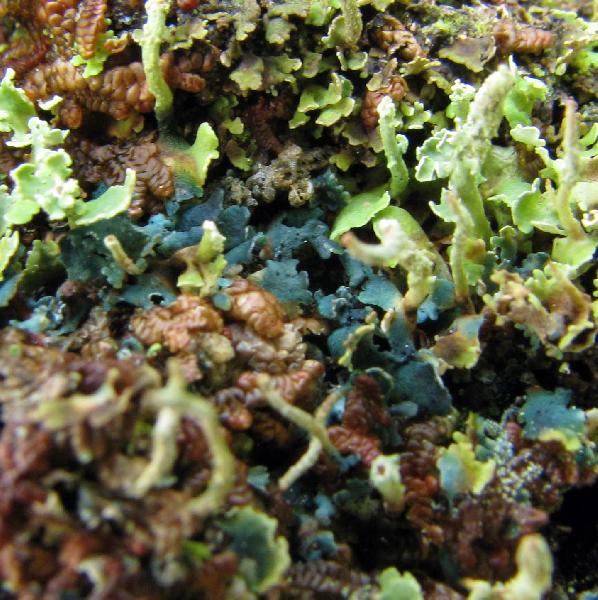Arthrorhaphis aeruginosa R. Sant. & Tønsberg
Lichenologist, 26: 295, 1994.
Synonyms:
Distribution: N - TAA (Brackel 2015, 2016), Lomb (Brackel 2010, 2013), Piem (Motiejunaitè & Grochowski 2014, Brackel 2016). C - Tosc (Brackel 2015, 2016), Umb (Brackel 2015, 2016), Laz (Brackel 2015), Abr (Brackel 2015, 2016), Sar (Brackel & Berger 2019). S - Camp (Brackel 2016, 2021), Cal (Brackel & Puntillo 2016, Brackel 2016)
Description: Thallus inapparent, developing inside the thalli of the host lichens and staining their surface blue-green, not lichenized. Apothecia rather rare, lecideine, black, sessile to substipitate, up to 0.4 mm across, with a concave disc and a prominent, up to 0.08 mm wide proper margin. Proper exciple up to 30 μm wide laterally, the outer part more or less paraplectenchymatous, bright blue-green, the inner part much paler, brownish; epithecium pale green; hymenium colourless, inspersed with oil droplets, up to 150 μm high, K/I-; paraphyses thread-like, c. 1 μm thick, free and lax, the apical cells hardly swollen; hypothecium colourless, up to 50 μm high. Asci 8-spored, subcylindrical to clavate, the wall of young asci with a poorly developed tholus and an ocular chamber, that of mature asci more or less uniformly thick throughout. Ascospores 12-28-septate, hyaline, needle like, parallel in the asci, 80-100(-120) x (2.5)3-4(-5) μm. Pycnidia rather common, black, up to 0.1 mm in diam., subglobose, the wall blue-green. Conidia tear-shaped, 2.5-3 x c. 1.5 μm. Photobiont absent. Spot tests: all negative, including the aeruginose and brown parts of apothecia. Chemistry: without lichen substances.Note: a lichenicolous fungus with a worldwide distribution, most common in montane and boreal forests, growing on Cladonia-species.
Growth form: Lichenicolous fungus
Substrata: bark, lignum, soil, terricolous mosses, and plant debris
Reproductive strategy: mainly sexual
paras Cladonia spp.
Commonnes-rarity: (info)
Alpine belt: rare
Subalpine belt: rare
Oromediterranean belt: very rare
Montane belt: rare
Submediterranean belt: extremely rare
Padanian area: absent
Humid submediterranean belt: extremely rare
Humid mediterranean belt: extremely rare
Dry mediterranean belt: absent

Predictive model
Herbarium samples
Growth form: Lichenicolous fungus
Substrata: bark, lignum, soil, terricolous mosses, and plant debris
Reproductive strategy: mainly sexual
paras Cladonia spp.
Commonnes-rarity: (info)
Alpine belt: rare
Subalpine belt: rare
Oromediterranean belt: very rare
Montane belt: rare
Submediterranean belt: extremely rare
Padanian area: absent
Humid submediterranean belt: extremely rare
Humid mediterranean belt: extremely rare
Dry mediterranean belt: absent

Predictive model
| Herbarium samples |
 Index Fungorum
Index Fungorum
 GBIF
GBIF



